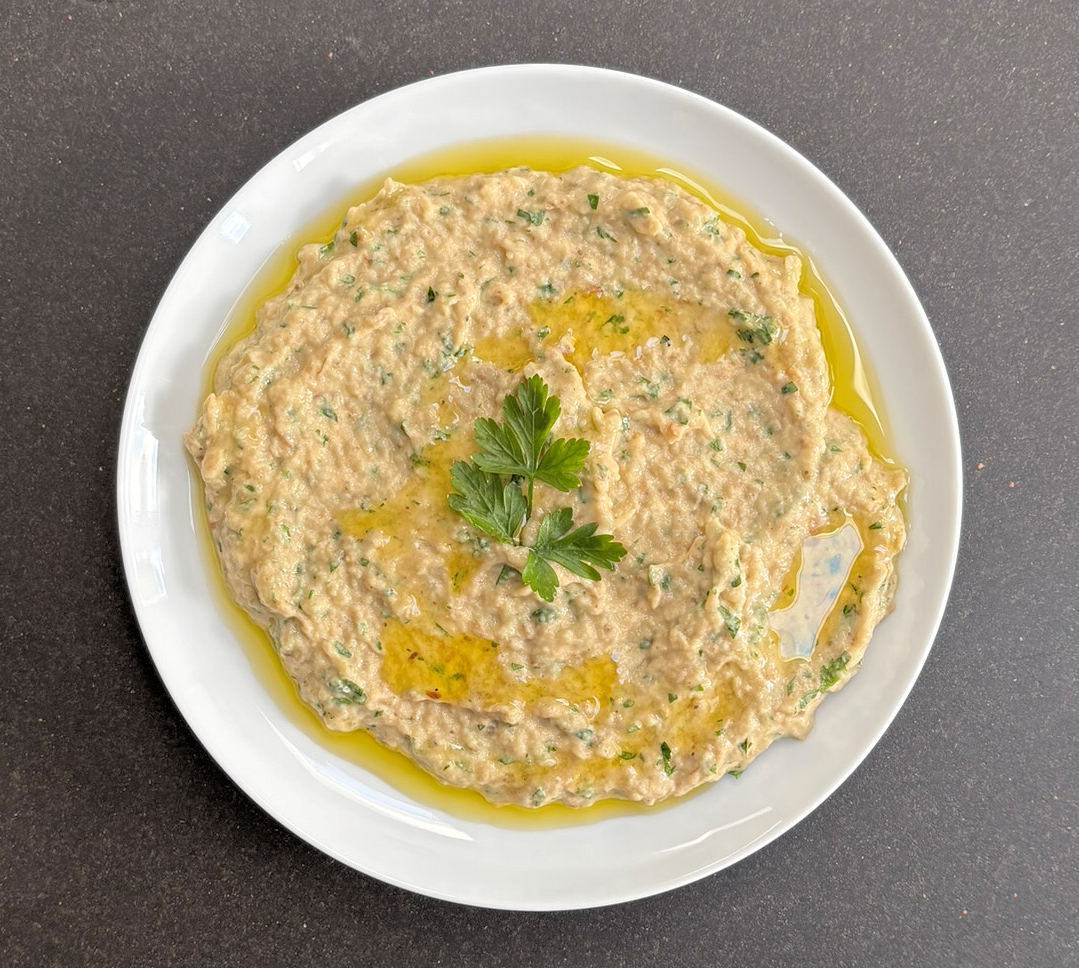Baba ganoush, delicious Levantine aubergine dip made with the aubergine roasted in the oven. My favourite item on a meze.

Meze, dips and good company
They do have some wonderful dips in the Middle East and Eastern Mediterranean, perfectly suited for dipping fluffy warm pita bread in.
The concept of meze is brilliantly convivial: a table laden with bowls and platters, with everyone around it armed with warm flatbread, reaching into the dips and scooping sauces.
Baba ganoush, muhammara, tzatziki, taramasalata and hummus – I honestly can’t decide which is my favourite.
What is baba ganoush?
It’s not exotic any longer, though not quite as ubiquitous on western tables as hummus. That’s probably because making it requires quite a bit of work and even though you can buy it in jars, that stuff is nothing like a freshly made dip. It’s all the nicer for it in my view.
Baba ganoush, ghanoush or ghanouj is made with roasted, almost burnt, whole aubergine which is then scooped out of the skin, creamed and seasoned. It originates from Levantine countries and with varied seasoning is present in cuisines from west Africa through to Armenia and Azerbaijan.
The name in Arabic means ‘spoilt daddy’ but it’s uncertain whether it refers to burnt and collapsed, 'spoilt' aubergine (badhnjan) or the diner being spoilt when presented with such a delicacy.
How to roast the aubergine?
That’s the seriously messy step. Arguably the best taste and flavour is from aubergine roasted directly in an open flame, over gas or wood fire. But the former means the kitchen full of smoke, the smell lingering for ages afterwards and the hob covered in burnt juices dropping from the aubergine. And the wood fire or outside grill is seasonally and logistically restricted.
You can use a griddle set on the hob but it won’t alleviate the smokiness. Since I struggle with good ventilation in my kitchen, I go for the oven grill: slightly less even cooking but the smells and vapours more controlled.
To cook an aubergine thoroughly enough for the baba, it needs piercing all over with a fork beforehand to avoid explosions. Then, be it over the hob or in the oven grill, it takes about half an hour with frequent turning it over for the skin to be completely burnt and the vegetable collapsed.
Once out of the grill, it needs to be wrapped in foil and left to rest and steam for fifteen minutes at least so the skin relaxes and peels easily.
Whipping and creaming
My recipe is based on Kenji Lopez-Alt’s one from Serious Eats, although I find his recommendation for draining or spinning the aubergine flesh superfluous – perhaps I’m not that discerning!
Once the roasted aubergine has rested, open it up and scrape the flesh out, taking care to avoid the burnt bits of skin that will insist on finding their way into the clean flesh. You can still quality-assure it for the black specks once it’s all in the bowl and you’ve started whipping it with a fork or a spoon.
Whipping and whisking is important for a creamy texture, but it’s not worth in my view to use a food processor. The aubergine flesh will emulsify pretty soon, with the additions of garlic and lemon, then tahini and olive oil.
Seasoning is the final step, and it’s entirely to your taste. I like to add some honey but leave it out if you prefer your savoury foods without even a hint of sweetness.
Serve baba ganoush spread on a plate, drizzled with more olive oil, with warm flatbreads on the side.
More Middle Eastern meze recipes
Muhammara, roasted red pepper and walnut dip, flavoured with pomegranate molasses and Aleppo pepper flakes. This should be a firm fixture in your next meze!
Mast-o-khiar is Persian yoghurt and cucumber dip with fresh herbs, walnuts and raisins. Samin Nosrat’s recipe suggests using labneh, strained yoghurt cheese, and that makes it a complete winner.
Roasted Romano peppers charred under the grill to skin and core them easily, marinated in an Ottolenghi-inspired dressing. They will disappear in a flash from your meze party.
More aubergine recipes
Aubergine parmigiana, or parmigiana di melanzane is the best Italian vegetable dish, made of layers of aubergine, mozzarella, homemade tomato sauce and basil. Topped with Parmesan, though that's not where the name is derived from!
Hot and spicy fried aubergine, a simple side or starter. Aubergine slices are dusted with flour to stop them guzzling oil too much and make the dish healthier.
Yu xiang aubergine, a Sichuan stir fry in fiery sauce. With added crunch of almonds and tartness of cranberries, it’s one of the best aubergine dishes ever.